
Blue Ocean Whale Watch, Moss Landing
Boat: High Spirits with Captain and Naturalist Kate Cummings, Naturalist Eric Austin Yee
Sightings: Humpback whales, Killer whales, Rissos
Blue Ocean Whale Watch Website
Blue Ocean Whale watch is an owner operated tour company working out of Moss Landing Harbor at
the mid point of Monterey Bay. BOWW’s boat is the 60 foot long High Spirt. She has a small upper deck (adults only and higher cost ticket) and the main deck with a nice enclosed seating area. While the boat has capacity of 47 but they are currently limiting their total passenger number to 28 between the upper and lower decks

As with all trips I’ve taken to-date, we started with a safety briefing. This one takes in a tiny picnic area at the end of the parking lot and in front of the gate access to Moss Landing Marina. After the briefing we headed, carefully, along the walkways between boats. Like most marinas the walkways are floating on the water, have no handrails, and take a bit of getting used to, I’d forgotten that part and it took a minute to find the rhythm of it. Once on the boat, I snagged a seat in the cabin near the wall where I could stash my stuff and sit down if I needed. I did in fact sit down once or twice, but not for long as there was so much to see.

Moving slowly out of the marina we went past Sea Lions, a Great White Heron, and a group of Cormorants. And of course, waved to the Stacks and headed into the very foggy morning.




20 minutes into our trip
The “Stacks”, are a pair of 500 foot tall smoke stacks which stand at the mid-point of the Bay. Originally built and operated by PG&E, today they are part of a natural gas powered electricity generation plant as well as one of the worlds largest battery energy storage facilities. There are problems and concerns about all of that, which the local community are working on. When out of the water, the Stacks can be seen from many points, making it a helpful landmark on and off the Bay. They are also cool as hell to look at up close, which explains the vast quantities of photos I have of them.
Humpbacks
Barely five minutes out from the dock we came across a pair, or more, of Humpbacks having a slow, foggy morning breakfast.
The whales were doing short dives. Going down with quiet curves of their back and the occasional full lift of their tail out of the water, hardly breaking the surface. They’d come up just as slowly, if a little louder because the sound of their blows was magnified by the fog. They’d glide for a little while then slowly go down for another nibble. At that hour of the morning, with all the fog, the water and sky were nearly the same shade of dusty gray making it hard to see where the where the two met.

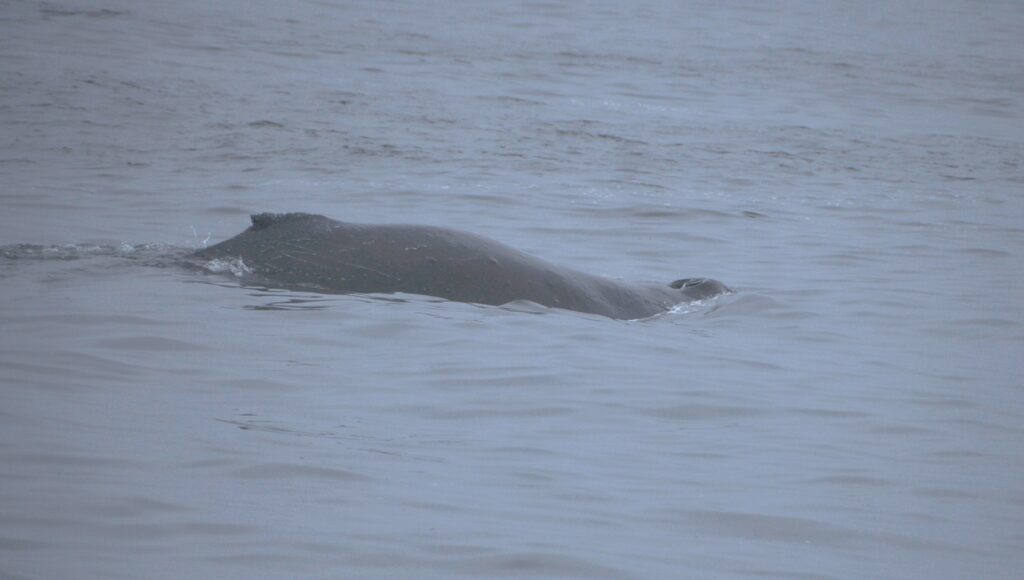
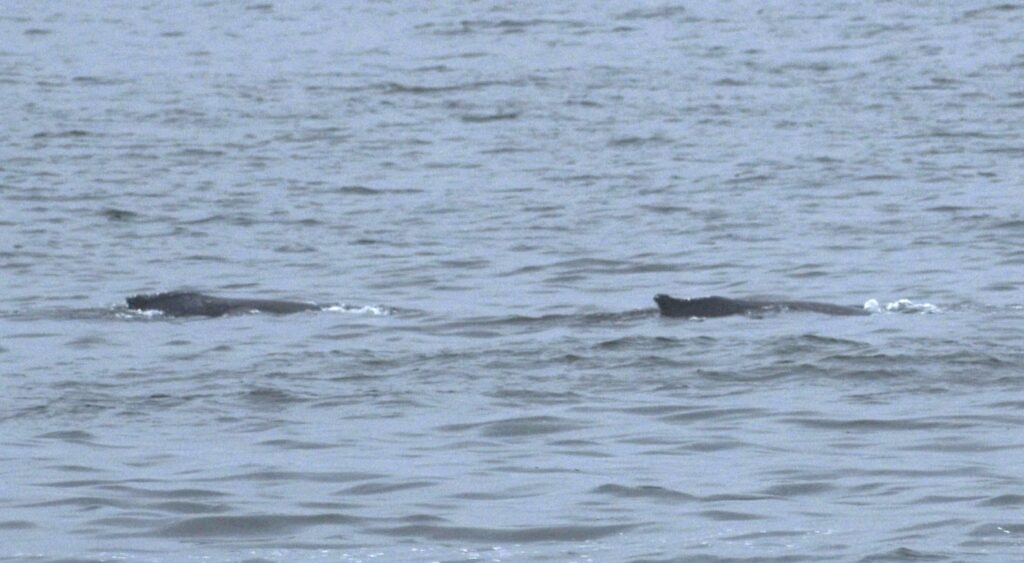

ORCA!!
Not long after we left the Humpbacks we came across a pod of Orca. This was so exciting. Orcas are well known visitors to Monterey Bay, but they are not full time residents of the area. The Orca groups that visit the bay are known as Transient Killer whales. These pods travel along the west coast of North America stopping where the feeding is good or the water is warm. This type of Orca almost exclusively eat marine mammals. Because of this they can be expected to visit in the late winter / early spring when the Gray whales are on their way north from the warm waters off of Mexico, where their calves are born. They also hunt Humpback, who make their way into the Bay from later spring to mid winter. Humpbacks can be a tricky meal as Humpbacks are well known for not just putting up a fight, but actively picking fights with Orcas. On rare occasions the Southern Resident Orca who live in the Salish Sea around [ ] will stretch their tails to make stops along the coast and even into Monterey Bay. As fish eaters, specifically salmon these Orca’s are not a danger to the whales, though I’m not sure if the whales know that.
Our pod was identified as a group of California Transients known as the CA140Bs, named for their Matriarch CA140B, Louise. With her were her daughters Stinger CA140B1, Bee CA140B2 and Buzz CA140B3, (Louise’s 2ish? year old calf). With them was a calf who was later confirmed to be Stinger’s calf by the CA Killer Whale Project . They were designates CA140B1A and are Stinger’s first known calf Louise’s first grandchild (Grandorca?)!


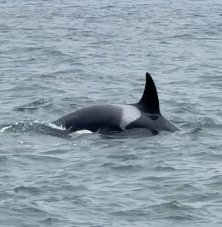
Meanwhile there was a Sea Lion at the edge of the show who decided that the boat was a nice, safe place to hang out while the Orca continued on their way.

Louise and her family have been back in Monterey a number of times in the weeks since I saw them, allowing researchers to confirm details and great some great photos of the family and newest calf, including the one below taken by Morgan Quimby. The calf’s white patches are tinged red/orange in the first months. They are born without much body fat and thin skin which mean the blood vessels are close to the skin, giving the calf an orange tint. The color will fade as the calf puts on weight until they are clearly black and white like the rest of their family.

Orca’s are identified by the shape and gradient of their saddle and eye patches. The saddle patches are a gray to white curved patch on their backs which begin at the base of the dorsal fin and flow toward their tails. The eye patch patch is an oval of white, generally above and behind the Orca’s eye.
There’s a nice lovely drone video taken of the family taken on March 11, 2025 link
Risso’s Dolphins
About twenty minutes after we lost sight of the Orca we came across a ‘pod’ of Risso’s Dolphins. Risso’s [latin] are…
In the wild travel dolphins in pods that can look small at the surface, so trying to count them is an art I need more practice in. Some times it seems like there are only a few dolphins at the surface, but really there are many than and they’re trading places as they swim – porpoising as they go. Unless a lot of them come to the surface at the same time or are milling around instead of swimming, its hard to see the whole pod in a single photo without a drone camera in the sky.



Video from Monterey Bay Whale Watch of Rissos https://www.facebook.com/reel/1220388029740351
Another Humpback – Breaching!
While we were moving on from the Risso’s, winding our way back to the harbor, we discovered a Humpback who was tail slapping, pec-slapping and breaching! Over and over again. It was so much fun to see.
The whale was identified on Happywhale as: HW-MN0503742


Photographing the underside of a Humpback whales’ tale can be an adventure, and often I wont known until I get home and have time to look through allllll the photos )about 700 for this trip) if I got any shots that are clear enough for an ID. Part of the issue is lighting and the whale’s movement. The two photos above are of the same whale. The image on the left shows more the flukes but is still not in full light. The second one show mostly the edge and tips, but now that it’s angle has shifted, there’s more light. The both show distinctive markings – some more obvious in the first: the circular barnacle scar mid point on the right side. With that mark now less distinct in the photo of the right, while the markings along the trailing edge of the flukes are clearer. On a different trip I photographed a whale with nearly all white tail flukes but they where heavily shadowed right up to the moment the whale’s decent brought the tail perfectly straight up into the air. The sun hit it like a planned spot light, showing the gorgeous flukes in all their pale glory.
Pec slaps
While the breaches were more spectacular, the pec slaps are also fun. These happen when the whale’s rolls on to their side at the surface, lifts its very long pectoral fin out of the water, sometimes holding it for a moment, then drops it down in a loud, explosive, slap against the water.
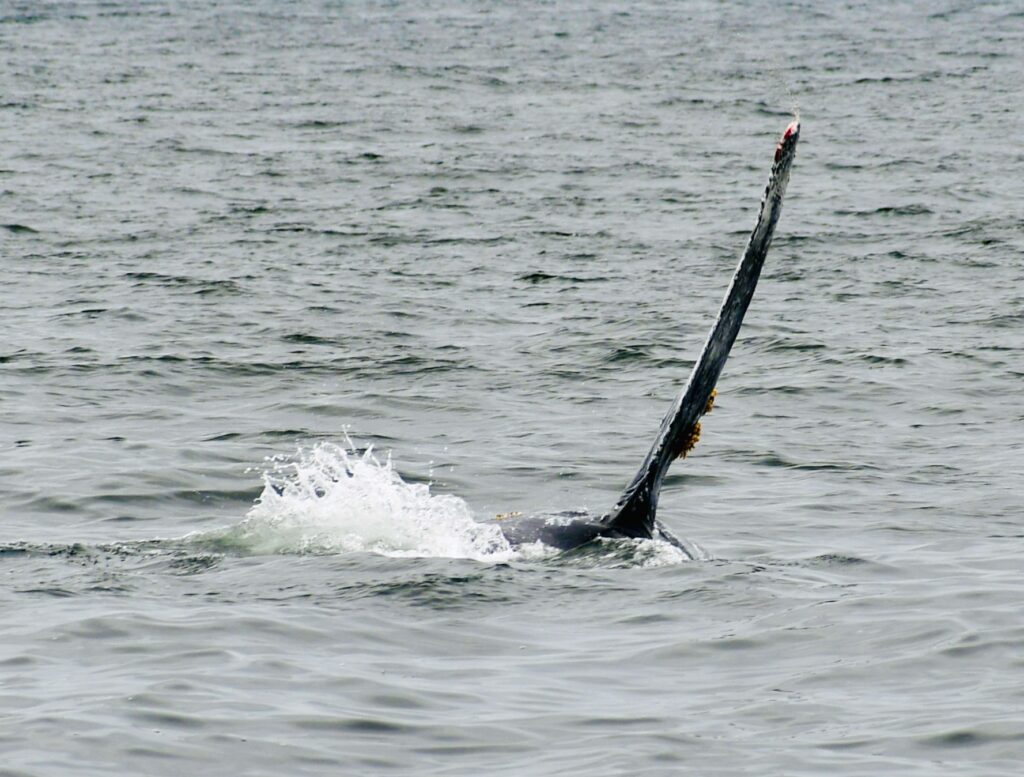


Tail lob
Tail lobs are similar to Pec slaps only done with the tail. And on this trip, the time we were close enough for photos, all mine demonstrate how much ‘fun’ it can be to take pictures of a moving whale while on a moving boat. I only mind because I’d love to have more of a record of what this whale was doing, but since I also got to see it in person, its all good.

Breach
A breach is when a whale hurls itself out of the water, twists in mid air and lands in a different position than it started in. All the ones I’ve seen are similar to this one. The whale comes up already angled backwards, turns (or continues turning) to land on its side. They are stunning displays of power, mass and agility.







This whale alternated behaviors throughout the 45 minutes we were with them, and we know they were doing them before we arrived and still doing them as we left. Pec slap, rest, repeat, swim a little one way, breach, rest, tail slap, rest, swim, breach… rest, breach… continue
And one of the times the whale came up right in front of a small boat that was watching the show! You can read about that here.
For a different perspective, here is an aerial view of a Humpback whale breaching. Video taken off the coast of Australia by Evie Wilderness.
We finally pulled ourselves away from the entertaining Humpback and started back to the Marina.
And as is often the case when a morning on the Bay begins with fog or overcast skies, by the time we’re heading back to dock, the weather has changed, often dramatically. The Monterey sky and clouds were showing off by the end of our trip! The fog had shifted to heavy, low lying clouds that looked like puffy white cotton at the top and shaded down, toward the shoreline, in darkening shades of blue-gray.
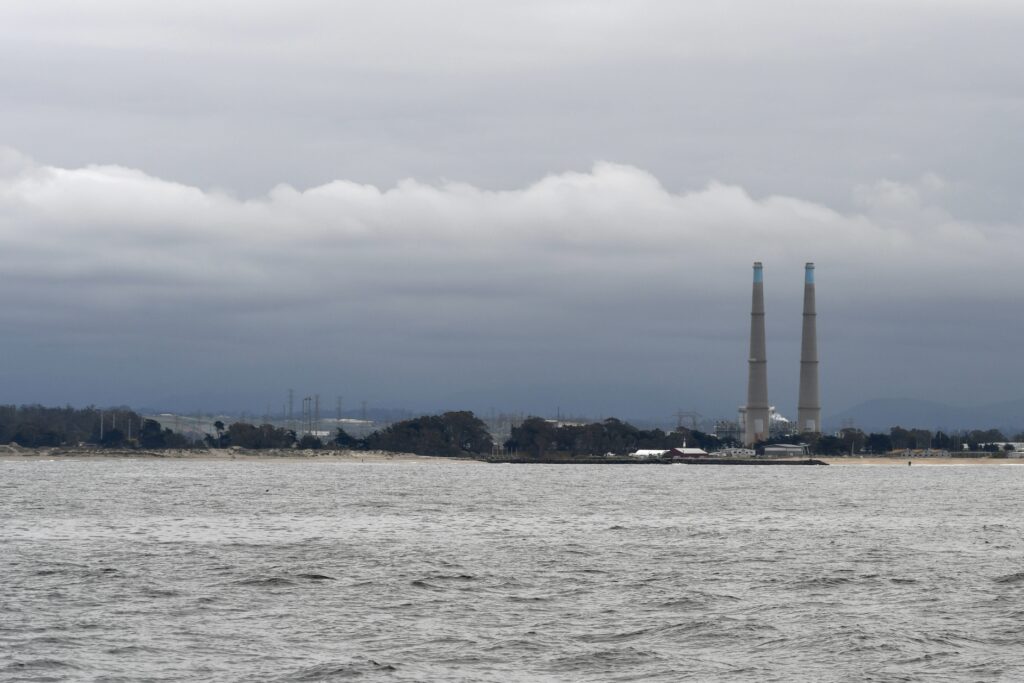
I really like going out with Blue Ocean Whale Watch. Both trips I’ve taken with them have been well run, exciting, and comfortable. The reduced crowd size is a definite plus as well… it makes for more room at the rails to see events up close.
Note: all photographs are (C) Catherine Pennington, 2025 unless otherwise noted.

What excellent photos! The whale breaching and slapping sounds like so much fun.
Thank you! breaching and slapping so fun to watch – I hope they are having as much fun doing it as we are watching 🙂